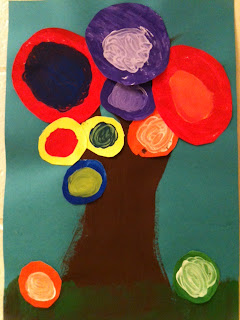With a little inspiration from Wayne Thiebaud and a fellow art teacher, my 5th graders practiced using value to create form and painted candy still lifes. Students used painting and drawing techniques to fill the space of their composition, show a 3 dimensional form on a 2d surface, and watercolor value.
Tuesday, October 23, 2012
Thursday, October 18, 2012
1st grade Color Trees
This was a popular idea in the art teacher internet world this year. I think it was a great way to get 1st graders thinking about color and what it can do.
Students practiced mixing secondary colors as well as light tints. Students discussed the artwork of abstract artist, Kandinsky, as well as Klimt. Both of these artists are known for their use of color and artwork involving trees. Students compared the artwork of these artists and created their own colorful tree.
Sometimes it's easy to get stuck in the perspective that students need to memorize information and then be able to repeat the rhetoric. Learning certain vocabulary words is very necessary, but I tried a different approach to color theory this year.
My first graders understand that color mixing creates new colors. They understand that there are different degrees of color and that combining them in different ways creates a different effect. My students might not always remember exactly which 2 colors create purple or which 2 colors create orange, but I guarantee that they can figure it out by looking at a color wheel.
Sometimes knowledge is figuring out how to find the answer rather than actually knowing the answer.
Students practiced mixing secondary colors as well as light tints. Students discussed the artwork of abstract artist, Kandinsky, as well as Klimt. Both of these artists are known for their use of color and artwork involving trees. Students compared the artwork of these artists and created their own colorful tree.
Sometimes it's easy to get stuck in the perspective that students need to memorize information and then be able to repeat the rhetoric. Learning certain vocabulary words is very necessary, but I tried a different approach to color theory this year.
My first graders understand that color mixing creates new colors. They understand that there are different degrees of color and that combining them in different ways creates a different effect. My students might not always remember exactly which 2 colors create purple or which 2 colors create orange, but I guarantee that they can figure it out by looking at a color wheel.
Sometimes knowledge is figuring out how to find the answer rather than actually knowing the answer.
Wednesday, October 10, 2012
3rd grade Abstract Art
3rd graders discussed Abstract Art and its history in culture. Does art have to have a subject? What is the meaning of abstract art? Does art have to look like something in real life? Students painted papers with the intermediate colors (yellow-green, red-purple, etc). By cutting geometric shapes and arranging them in a repetitive and balanced way, students created abstract art!
I think this project encouraged students to think outside the box. Students were able to use their creativity to create simple and repetitve geometric designs. Students were encouraged to cut their shapes in new and creative ways. They were encouraged to be unique.
2nd grade Seascapes
2nd grade students discussed the art form of seascapes. What mood is given from looking at the ocean? Can artwork tell a story? Students used warm and cool colors and mixed tints to create their seascapes. Students had fun adding their own personal details that helped tell a story about their painting. Final pictures coming soon!
4th grade Cityscapes
4th graders are in the process of creating evening cityscape paintings. We looked at many cityscapes made by many artists including Georgia O'Keeffe. Students practiced drawing from observation by looking at a photograph of the Atlanta skyline. Students discussed analogous colors, values, and contour line.
Finished Products!
Monday, October 1, 2012
5th grade Action Op Art


5th graders learn a lot during this project. We discussed how the Olympics are an important part of culture and students practiced capturing action poses by drawing gestures. Students also discussed how lines create movement by looking at various OP artists and created a color scheme design in the background. The OP is short for optical illusion. Finally, students created Emphasis by placing their large, contrasting gesture in the middle of the page.
Subscribe to:
Posts (Atom)







































